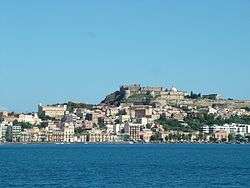Milazzo
| Milazzo | |
|---|---|
| Comune | |
| Comune di Milazzo | |
 View of the Castle, Old Cathedral, Ancient "Borgo", and part of waterfront of the city center. | |
| Nickname(s): The cape town | |
.svg.png) Milazzo within the Province of Messina | |
 Milazzo Location of Milazzo in Italy | |
| Coordinates: 38°13′N 15°14′E / 38.217°N 15.233°E | |
| Country | Italy |
| Region | Sicily |
| Metropolitan city | Messina (ME) |
| Government | |
| • Mayor | Giovanni Formica |
| Area | |
| • Total | 24.23 km2 (9.36 sq mi) |
| Elevation | 1 m (3 ft) |
| Population (31 May 2016)[1] | |
| • Total | 31,527 |
| • Density | 1,300/km2 (3,400/sq mi) |
| Demonym(s) | Milazzesi, Mamertini or Milaiti |
| Time zone | UTC+1 (CET) |
| • Summer (DST) | UTC+2 (CEST) |
| Postal code | 98057 |
| Dialing code | 090 |
| Patron saint | St. Stephen |
| Saint day | First Sunday of September |
| Website | Official website |
Milazzo (Sicilian: Milazzu, Latin: Mylae[2]) is a town (comune) in the Metropolitan City of Messina, Sicily, southern Italy; it is the largest commune in the Metropolitan City after Messina and Barcellona Pozzo di Gotto. The town has a population of around 31,500 inhabitants.
History
Several civilizations settled in Milazzo and left signs of their presence from the Neolithic age. In Homer's Odyssey Milazzo is the place where Ulysses is shipwrecked and meets Polyphemus.
Historically, the town originated as the ancient Mylae, an outpost of Zancle, occupied before 648 BC, perhaps as early as 716 BC.[3] It was taken by the Athenians in 426 BC. The people of Rhegium planted the exiles from Naxos and Catana in 395 BC as a counterpoise to Dionysius the Elder's foundation of Tyndaris; but Dionysius soon took it. In the bay Gaius Duilius won the first Roman naval victory over the Carthaginians (260 BC).
In 36 BC the naval Battle of Mylae was fought offshore. The fleet of Octavian, commanded by Marcus Agrippa, engaged that of Sextus Pompey. While the battle was nearly a draw, Sextus could not replace his losses, and was thus weaker at the following Battle of Naulochus (36 BC), where he was utterly defeated.[4]
After the fall of the Western Roman Empire, under the Byzantines, the town became one of the first episcopal seats of Sicily. In the 9th century Milazzo was conquered by the Arabs, who built the first nucleus of the castle here. Frederick II of Hohenstaufen further fortified the town and created a personal hunting park. The castle was later mostly rebuilt in the age of Charles V of Spain.
Milazzo was also the seat of a battle in 1718 between Spain and Austria, and of another fought by Giuseppe Garibaldi against the Kingdom of Two Sicilies during his Expedition of the Thousand.
Geography
Milazzo borders with the municipalities of Barcellona Pozzo di Gotto, Merì and San Filippo del Mela.[5]
Milazzo is the point of reference of a vaste territory, from Villafranca Tirrena to Patti (over 200,000 inhabitants). Is also, an important centre of the Strait of Messina Metropolitan Area (who also includes areas of Reggio Calabria), with the nearby town Barcellona Pozzo di Gotto. Located at the base of a peninsula that juts into the Tyrrhenian Sea with a small promontory, the town is 43 kilometres (27 mi) from the city of Messina.
Main sights
- Castle of Milazzo. Begun by the Arabs, enlarged by the Normans, restored and strengthened by Frederick II, it is surrounded by walls with round towers built under Alfonso V of Aragon, with a Gothic portal dating from the 14th century. Near the castle are the ruins of the fourteenth-century palace of the grand jury and the old cathedral (1603) probably built on a design by architect Camillo Camillians.
Other sights include:
- the Church of Our Lady of Mount Carmel
- the Baroque Church of the Holy Crucifix (1629), housing a wooden canopy from the 18th century and a wooden crucifix from the early 17th century.
- Rock church of St. Anthony of Padua
- Sanctuary of St. Francis of Paola
Economy
Over time, the town is moving forward towards the sea by recording a continuous development of agriculture and fishing activities, commercial and industrial.
Transportation
The port of Milazzo is a departure point for ferries to the Aeolian Islands and Naples.
See also
References
| Wikisource has the text of the 1911 Encyclopædia Britannica article Milazzo. |
- ↑ (in Italian) Source: Istat 2011
- ↑ Richard Talbert, Barrington Atlas of the Greek and Roman World, ( ISBN 0-691-03169-X), Map 47, notes.)
- ↑ E. A. Freeman, History of Sicily, I., pp. 395, 587
- ↑ Dio 49.1–18
- ↑ 39568 Milazzo on OpenStreetMap
External links
| Wikimedia Commons has media related to Milazzo. |
- (in Italian) Milazzo official website
